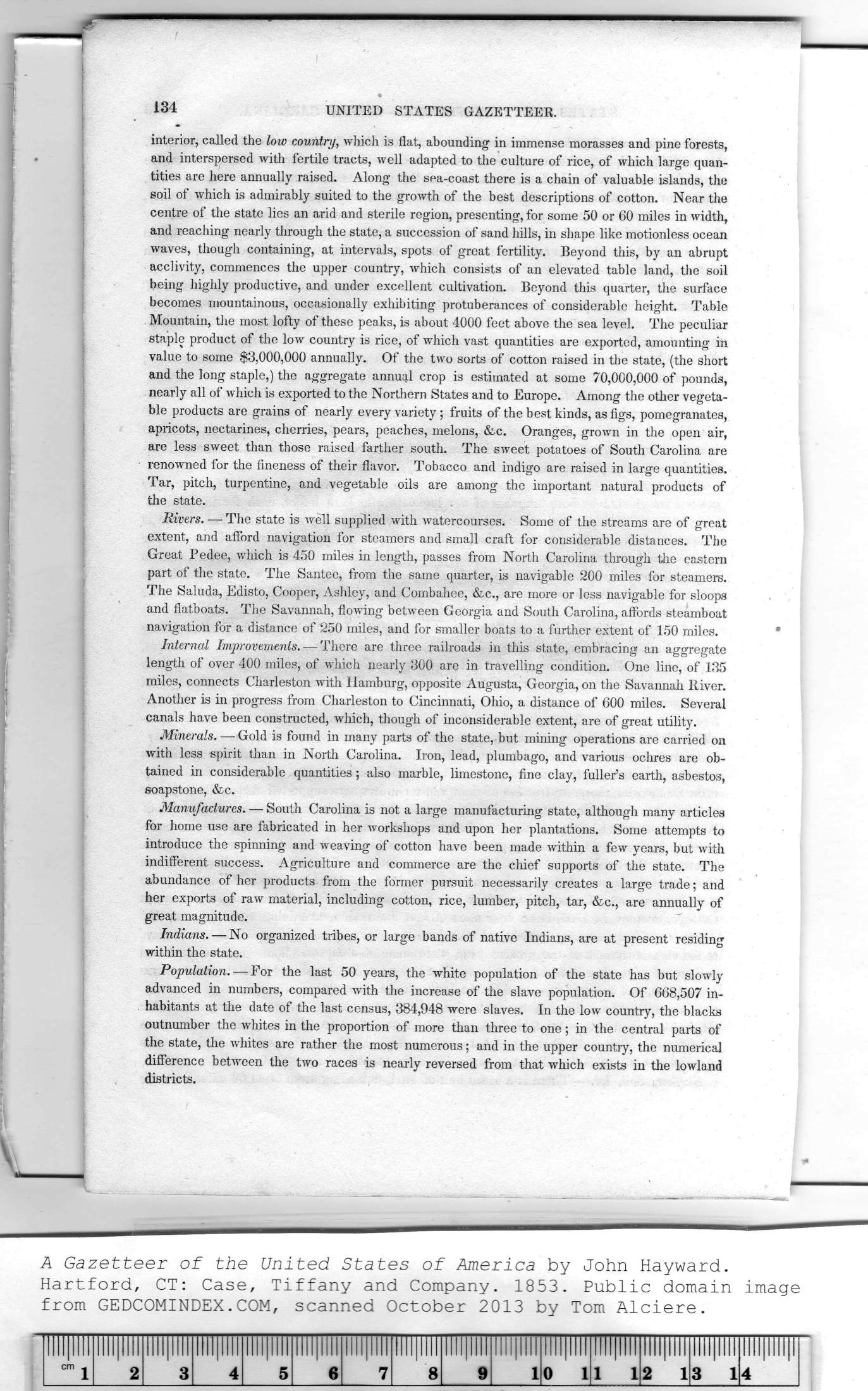|
|
Note: Ctrl and + increases the font size of the text below, Ctrl and - decreases it, and Ctrl and 0 resets it to default size.
134 UNITED STATES GAZETTEER.
interior, called the low country, which is flat, abounding in immense morasses and pine forests,
and interspersed with fertile tracts, well adapted to the culture of rice, of which large quan-
tities are here annually raised. Along the sea-coast there is a chain of valuable islands, the
soil of which is admirably suited to the growth of the best descriptions of cotton. Near the
centre of the state lies an arid and sterile region, presenting, for some 50 or 60 miles in width,
and reaching nearly through the state, a succession of sand hills, in shape like motionless ocean
waves, though containing, at intervals, spots of great fertility. Beyond this, by an abrupt
acclivity, commences the upper country, which consists of an elevated table land, the soil
being highly productive, and under excellent cultivation. Beyond this quarter, the surface
becomes mountainous, occasionally exhibiting protuberances of considerable height. Table
Mountain, the most lofty of these peaks, is about 4000 feet above the sea level. The peculiar
staple product of the low country is rice, of which vast quantities are exported, amounting in
value to some $3,000,000 annually. Of the two sorts of cotton raised in the state, (the short
and the long staple,) the aggregate annual crop is estimated at some 70,000,000 of pounds,
nearly all of which is exported to the Northern States and to Europe. Among the other vegeta-
ble products are grains of nearly every variety; fruits of the best kinds, as figs, pomegranates,
apricots, nectarines, cherries, pears, peaches, melons, &c. Oranges, grown in the open air,
are less sweet than those raised farther south. The sweet potatoes of South Carolina are
renowned for the fineness of their flavor. Tobacco and indigo are raised in large quantities.
Tar, pitch, turpentine, and vegetable oils are among the important natural products of
the state.
Rivers. — The state is well supplied with watercourses. Some of the streams are of great
extent, and afford navigation for steamers and small craft for considerable distances. The
Great Pedee, which is 450 miles in length, passes from North Carolina through the eastern
part of the state. The Santee, from the same quarter, is navigable 200 miles for steamers.
The Saluda, Edisto, Cooper, Ashley, and Combahee, &c., are more or less navigable for sloops
and flatboats. The Savannah, flowing between Georgia and South Carolina, affords steamboat
navigation for a distance of 250 miles, and for smaller boats to a further extent of 150 miles.
Internal Improvements. — There are three railroads in this state, embracing an aggregate
length of over 400 miles, of which nearly 300 are in travelling condition. One line, of 135
miles, connects Charleston with Hamburg, opposite Augusta, Georgia, on the Savannah River.
Another is in progress from Charleston to Cincinnati, Ohio, a distance of 600 miles. Several
canals have been constructed, which, though of inconsiderable extent, are of great utility.
Minerals. — Gold is found in many parts of the state, but mining operations are carried on
with less spirit than in North Carolina. Iron, lead, plumbago, and various ochres are ob-
tained in considerable quantities ; also marble, limestone, fine clay, fuller's earth, asbestos,
soapstone, &c.
Manufactures. — South Carolina is not a large manufacturing state, although many articles
for home use are fabricated in her workshops and upon her plantations. Some attempts to
introduce the spinning and weaving of cotton have been made within a few years, but with
indifferent success. Agriculture and commerce are the chief supports of the state. The
abundance of her products from the former pursuit necessarily creates a large trade; and
her exports of raw material, including cotton, rice, lumber, pitch, tar, &c., are annually of
great magnitude.
Indians. — No organized tribes, or large bands of native Indians, are at present residing
within the state.
Population. — For the last 50 years, the white population of the state has but slowly
advanced in numbers, compared with the increase of the slave population. Of 668,507 in-
habitants at the date of the last census, 384,948 were slaves. In the low country, the blacks
outnumber the whites in the proportion of more than three to one; in the central parts of
the state, the whites are rather the most numerous; and in the upper country, the numerical
difference between the two races is nearly reversed from that which exists in the lowland
districts.
|
